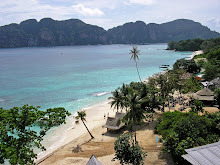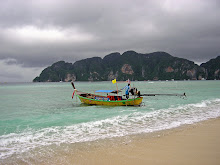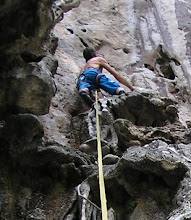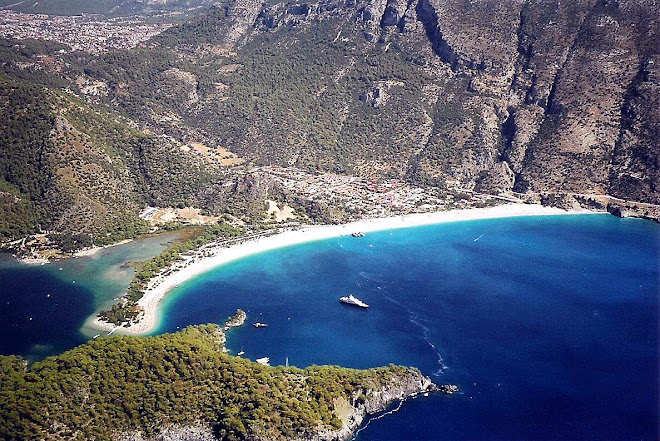This page deals with the north Aegean locations of Canakkale, Gallipoli, Troy, Pergamon and Kusadasi.
----------------
CANAKKALE-GALLIPOLI-TROY
Canakkale (say Cannackally) is the provincial capital and sits on the south side of the narrow Dardanelles Strait at its narrowest point about 25km in from the open ocean. All ships wanting to access areas around Istanbul or go further into the Black Sea must pass by this area.
Canakkale has 100 thousand permanent residents and another 30 thousand university students during term. Its temperate climate and good amenities have attracted more than the usual share of better-off Turkish retirees.
Because it is so close to both the WW1 Gallipoli battlefields and Troy it attracts large numbers of tourists, both international and Turks and so has a fine array of hotels, restaurants and shopping.
The above pic is shot from the vehicle ferry between Ecobat on the European side and Canakkale on the Asian side. Because the ferries are a link in the east coast highway they tend to run frequently.
Canakkale is 5-6 hours by bus (incl a short ferry ride across the Dardanelles) west-south-west from Istanbul and very close to both the the Gallipoli battlefields and Troy. Ecebat is a smaller town opposite Canakkale - closer to the battlefields but further from Troy. Both are good bases because the frequent car ferry transfers take less than 30 minutes to cross the narrow strait at this point. Note that Aegean is spelled incorrectly on the map, but it takes too long to correct so it stays.
Canakkale has a sweet waterfront promenade packed with restaurants and bars - the perfect places to grab a drink etc and watch the passing parade of ships, yachts and ferries. People watching is pretty good too.
Vehicle ferry about to dock. Buses from the European side roll off and stop just behind camera at the bus company offices where many people get off on account much of the accommodation is closer to here than the bus station about 600m inland. About 100m behind camera on the main street leading inland is Crowded House Tours, housed in the popular Anzac House Hostel (don't confuse with Anzac Hotel, also in the area). The strip of waterfront restaurants and bars start directly left of camera. The replica wooden horse (see pic down page) is along the waterfront right of camera. There is no shortage of hotels, restaurants and bars on the other side of the road along this section.
Further left of the above shot is the military museum, housed in a park (lots of old guns and torpedoes on display) and an old-time fort. The replica of the Nurset minelayer (see pic down page) is moored right of camera.
Modified Google Earth image to show most places mentioned. I stayed at Egem Pension, a nice budget place less than 5 minutes walk off the ferry and 3 from the waterfront restaurants and main drag leading inland from the ferry. Friendly staff and good inclusive Turkish buffet breakfast. Cannakale has no shortage of accommodation in all price ranges.
Gallipoli
After the British and French navies failed to force a passage thru the Dardanelles in WW1, the First Lord of the Admiralty Winston Churchill had the brilliant idea of landing an invasion force of Australian, New Zealand, French and British troops on the Aegean side of the narrow Gallipoli peninsula, storming the heights from where they could easily overrun the Dardanelles shore and open the Straits to allied shipping for an attack on Istanbul and a supply route to Russia. However stupid mistakes and the ferocious defence put up by the Turks doomed this campaign to failure.
Major points of the Gallipoli campaign. The heights around Chunuk Bair were the main objectives of landings at Anzac Cove and Suvla Bay. French and British landings at Cape Helles in the south were aimed at controlling the high ground near the mouth of the Dardanelles.
The campaign has great importance to Australia and New Zealand because it was the first real chance for these young nations to forge their national identity. April 25, the date the first troops stormed the beaches, is celebrated in both countries as THE day of remembrance for casualties and survivors in ALL the wars they have fought - ANZAC (Australian and New Zealand Army Corps) DAY. It is similarly important to Turks who see it as the first real test of modern Turkey. They defended ferociously, often to the last man and out of ammunition - and kicked arse which adds to national pride.
Brighton Beach (the invasion force's name) was the intended landing point for the Anzac troops - it had a much better landing zone and the path up to the heights was considerably easier. If you click image to expand you will see the white memorial at the Turkish soldiers' site at Chanuk Bair, the Anzacs' general objective. However a navigation mistake by the British navy took the actual landing around the far point to Anzac Cove.
Note that Brighton Beach is a popular leisure destination for Turks today - nice sand and water plus a neat camping ground behind the trees right mid-shot.
Anzac Cove from the southern point - only 400m long, deeper water offshore (quite a few Anzacs drowned coming ashore) and with much steeper, rougher, easier to defend ground behind. There were no coastal road or retaining walls in those days.
Anzac Cove was so small that the landing spilled around its north corner in foreground of pic to North Beach. Note the rugged country in background - it is actually higher and steeper behind Anzac Cove. The Anzacs fought their way inland and upwards but never managed to hold the high ground for any length of time. The heroic defence from the Turks inflicted such casualties here and at Cape Helles in the south (where the British and French never managed to get any distance off the beach) and Suvla Bay in the north (a later landing by British troops largely unopposed which was going well until the British commander decided to stop and regroup [our Turkish guide* said he stopped for a cup of tea]which gave the Turks time to rush troops in who pushed the Brits back) that it was eventually decided to withdraw from the area.
Loss of life was great - 88000 Turks, 44000 Brits and French, 6000 Aussies and 3000 Kiwis - note that most of the allied survivors were then transferred to the Western Front in France which was even more hazardous).
*My tour was run by the legendary Crowded House travel agency a very short distance up the main street from the ferry and bus stops in Canakkale (right hand side). The timing is such that you can do the much shorter Troy tour in the morning before kicking off around 1130 for Gallipoli (first is an inclusive lunch in Ecebat). The guide was excellent giving a balanced yet impassioned commentary of the campaign. Crowded House also runs people down from Istanbul to do Gallipoli - some go back the same day (strewth!) but others stay and do Troy next day or enjoy Canakkale or Ecebat for a while. Crowded House offers many other tours and services.
One of the biggest Anzac war cemeteries is in the heights at Lone Pine. Many of the graves don't contain bodies - they were never recovered but a headstone has been provided for the missing. Quite a few of the dead were in their mid-teens - they lied about their age for a shot at the big adventure.
A little higher near Chunuk Bair is the Turkish Soldiers' Memorial. Quite big groups of Turkish tourists were gathered here and at other spots.
New Zealand soldiers actually reached Chunuk Bair for a short time but the Turks counter attacked fiercely and pushed them back.
Remnants of trenches near Chunuk Bair. In some cases the opposing front line trenches were only 5m apart. At first this was accidental - retreating troops would leap into the first reserve trench and their pursuers into the trench their adversaries had just vacated. But they soon realised that the closeness had advantages - it made the use of mustard gas too dangerous - ditto grenades which most likely would be thrown back ("timing" grenade throws was a risky business in those days of unreliable fuses). It also bred a curious sense of camaraderie with the enemy between violent sorties - hungry Anzacs would throw tobacco and cans of beer across the gap and get a shower of dates, figs and cooked local stuff in return. There were also negotiated cease-fires where each side would recover and bury the bodies of comrades.

Many Turks believe this shows the real winner of the campaign. Here is a replica of the minelayer Nurset which sneaked out at night and replaced some of the mines allied minesweepers had cleared before the French/British naval attempt to storm the Dardanelles. A french battleship hit one of the mines and sank which saw an abandonment of the naval sortie - the loss of one obsolete battleship (the newer ones were kept in the north Atlantic to take on the German fleet) and several hundred sailors subsequently cost the lives of over a hundred thousand troops.
This replica is in the military museum which is in and around an old Ottoman empire fort just past the far western end of the seafront promenade in Canakkale.
TROY
The ruins of the ancient city are about a 40 minute drive south-west of Canakkale. It is generally agreed they are nowhere near as impressive as Pergamon and Ephesus further south - nevertheless I found the site interesting. Many regard Troy as a myth but excavations reveal there were at least 9 different cities here over the period 3000BC-first century BC - some were destroyed by earthquake/fire, some by war. It is generally thought that if Homer's yarn about Helen, Paris and the wooden horse is true it most likely occured in early Troy #7 - 1300 to 950BC. The city declined after Troy#9 because the estuary of the adjacent river silted up placing the city too far from the sea to facilitate trade. The growth of Constantinople in this period as a trading opponent did not help.
Once again I went with Crowded House whose guide did an excellent job in presenting both the mythical and archaeological interpretations of the ruins. The guided tours are not time consuming, taking something like 3 hours Canakkale/Canakkale and are inexpensive.
One of the best preserved sections of the ruins, part of the Roman era Troy#9.
Remnants of the walls of city#7 - these have been partially reconstructed because the early German archaeologists were more plunderers than historians. Much of the jewelry removed from the site ended up in Berlin museums and was subsequently swiped by the Russians at the end of WW1. The Turkish govt has asked for it back, to which they get the big NYET.
Cheesy wooden horse is outside the administrative offices - you can climb up into it and act like a Greek soldier.
This better looking dude was constructed for the recent movie - is now on display on the eastern seafront promenade in Canakkale near the marina.
--------------------------------
PERGAMON
I needed to get from Canakkale to Kusadasi, a resort city several hundred km south to catch a ferry to the Greek island of Samos.
The bus schedules didn't make the journey easy and when I learned Crowded House had a van going to Kusadasi with a stop-over at the ruins of ancient Pergamon I jumped at it. Crowded House was also going to tour Ephesus the next day but I gave that a miss figuring I'd be overdosing on ancient ruins if I did 3 in a row. Note Kusadasi is mispelled on the above map, but once again correcting it is too time consuming. Please excuse spelling on map, but as said it's too time-consuming to fix.
The ruins at Pergamon are much more impressive than at Troy. These are the remains of the Temple of Tarjan. The city was the capital of the Kingdom of Pergamon, an independent Greek-Turkish state in the 3rd/2nd century BC which allied itself closely to Greece and later to Rome. The city was built high on a promontory which made attack very difficult. Interestingly, early Christian teachings said Pergamon was Satan's home.
The large theater has excellent acoustics and people come up from the large town of Bergama today for special performances.
These passageways are behind the temple and have small rooms off to the side used for shops etc back in the day.
During my Turkey visit I avoided carpet sellers but Crowded House's Pergamon guide actually comes from this carpet making co-op in the area and invited us back to see the carpet making process. I was particularly impressed in the above, where silk thread is being spun off heated cocoons in the cauldron (I don't think the enclosed pupae were too impressed). The thread is so fine you can't see it going up and past the woman's hand. The area where the carpets are woven (local women weave the silk, wool or composite threads into the carpet in a minimum of several hundred thousand hand-tied knots, which explains why hand-made carpets are so expensive) was also fascinating. There was no hard sell but certainly some soft sell, which a few members of our group took advantage of - they knew something about carpets and told me the prices were very competitive. I liked the price of the wine at the showings - free.
------------------------
KUSADASI
This resort town is the type of place publications like Lonely Planet warn readers about using terms like "brash" and "touristy". I thought it was very good value - lots of sidewalk restaurants and bars with competitive pricing; a great pedestrianised bazaar area with good shopping/more restaurants/some very competitive money changers; a huge range of accommodation and lots of people having a good time - at least 80% of them Turks at the time of my visit in September (shoulder season).
The above was shot from Pigeon Island which has a neat fort and is a nice spot for a stroll or viewpoint. The town has a permanent population of about 70000 which swells to over half a million in high season - buildings stretch several km along the coast both sides of image.
Like most Aegean towns there is a variety of boat trips available out of Kusadasi although not to the same extent as further south in Bodrum, Marmaris or Fethiye. These boats are berthed on the causeway out to Pigeon Island.
The town has several beaches, the best known being Ladies' Beach a few km south of town central (that's Pigeon Island far background-left). I wasn't real impressed with sand quality/width and the fact that a lot of the beach was covered by sun lounges - but I was by the water quality, which was the clearest of any city beach I've experienced. I also loved the restaurant promenade to right of shot (see below).
Australian public beaches never have permanent sun lounges/umbrellas thank God, but I can't think of any which have neat concourse restaurant/bar areas like this either. A great spot to spend some time with super-competitively priced food and drink and watch the passing parade. The Ladies' Beach area has a huge range of holiday apartments and resorts.
I'll call this Town Beach on account it is very close to town central. Pretty nice for a town beach - a step up from the town beaches at Bodrum and Marmaris further south.
Places mentioned in this section. I stayed at Hotel Istankoy - an inexpensive place on the booking sites which turned out to be a better than the price suggested. Good position - less than 2 minutes from the bay-front promenade and the town beach and 10 from the bazaar area. Lots of hotels in this area. Hell, lots of hotels all over Kusadasi.
Kusadasi is a popular stop on the Mediterranean/Aegean cruise boat circuit. This big baby came shortly before I was leaving on the ferry for Samos (from which this is shot) and there was a constant procession of passengers disembarking to explore the town or check out nearby Ephesus. The biggest steel hulled sail boat I've seen was tied up to a pier to left of image - all sleek, white hulled and obviously for luxury cruising..
--------------------------------------------------------------
XXXX - If you have any questions, please ask them in THE FORUM rather than below. I don't get a chance to check all threads daily, but unless I'm travelling I'll try to monitor THE FORUM regularly.
BACK TO INDEX













































1 comment:
your information here is useful and interesting.
Thanks
this article is genuinely a good one it helps new web people..
i like your blog..
Student accommodation close to De Montford University | Student accommodation close to Leicester University
Post a Comment